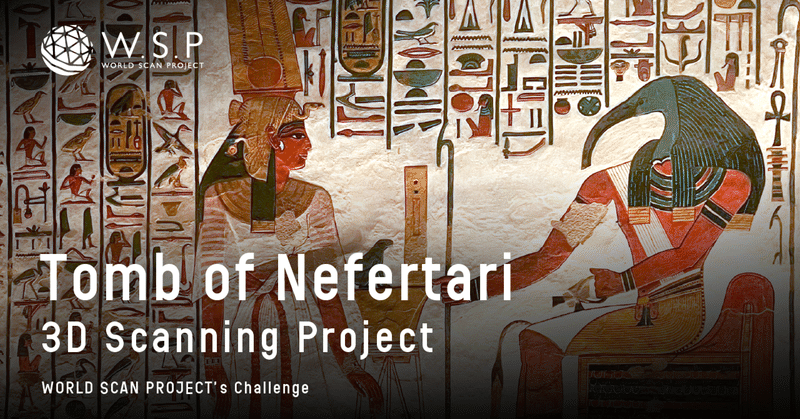
Tomb of Nefertari 3D Scanning Project - WORLD SCAN PROJECT’s Challenge
Celebrated as one of Egypt's greatest pharaohs, Ramesses II was revered for his monumental achievements. Among his many wives and concubines, Queen Nefertari was the most beloved. But who exactly was Nefertari? In this feature brought to you by the World Scan Project (W.S.P.), we present our research and the life of Queen Nefertari and her elaborate tomb.
Queen Nefertari
Nefertari, the first wife of Ramesses II, the third pharaoh of the 19th dynasty, is one of the most famous queens in Egyptian history. Her origins remain shrouded in mystery, as she did not bear the title of "King's Daughter," suggesting that she was not of royal blood, but possibly of Egyptian nobility. The name Nefertari, meaning "the one beloved by the goddess Mut," indicates her esteemed status. Deeply loved by Ramesses II, this affection was immortalized in the small temple at Abu Simbel dedicated to her.

Tragically, Nefertari passed away before Ramesses II, who then entombed her in a beautiful resting place. This small tomb, renowned for its well-preserved state and stunning wall paintings, is today considered one of Egypt's most beautiful monuments.
The beautiful tomb of Nefertari
In 1904, the Italian archaeologist Ernesto Schiaparelli made a groundbreaking discovery in the Valley of the Queens on the west bank of the Nile in Luxor: the tomb of Nefertari. Unlike the Valley of the Kings, where pharaohs were buried, the Valley of the Queens was primarily for the burial of queens, princes, princesses, and other members of the royal court.
At the time of its discovery, the interior was damp and the walls were deteriorating from accumulated salt. However, restoration efforts from 1986 to 1992 brought its stunning beauty back to life. Today, the tomb is renowned for its magnificent murals and commands the highest entrance fee of any Egyptian monument, a testament to its value.

The entrance to Nefertari's tomb begins with a staircase carved into the rock leading to an antechamber where the ceiling is decorated with a dark blue starry sky. Here were depicted gods welcoming Nefertari and paintings based on Chapter 17 of the Book of the Dead. Scenes of Nefertari playing the ancient board game Senet symbolize her struggle against fate, winning eternal life through victory.

The Vivid Murals of Nefertari's Tomb
The murals that adorn the walls are so vivid that it's hard to believe that thousands of years have passed since they were created, allowing us to follow Queen Nefertari's journey into the afterlife. In the entrance hall, Nefertari is led by the goddess Isis into the presence of Osiris, the god of the underworld.

Facing the entrance to the side chamber, the gods Osiris and Atum, the creator god of ancient Egypt, are depicted symmetrically with a fan in the center. The offerings piled before them, including the body and organs of a bull, as well as the face and luxurious incense, reveal the extent of their worship.

Adjacent to this scene is an excerpt from Chapter 94 of the "Book of the Dead" in which Nefertari confronts Thoth, the god of wisdom and magic, holding a palette to be offered to him. Notably, behind the palette is a frog, represented in hieroglyphs as "Heqet," which also means a hundred thousand, symbolizing Nefertari's desire for eternal life.

3D Scanning Survey of Tomb of Nefertari
The excitement and impression we felt when we first entered this tomb is indescribable. It was a great pleasure for us at the World Scan Project (W.S.P.) to have the opportunity to 3D scan this precious tomb.
The scanning was carried out with the utmost care, successfully digitizing the tomb in great detail without any contact with the walls. Capturing the murals' intricate details enables us to study the art and mythology of Nefertari's era, free from the constraints of time and location. Moreover, applying this technology to VR and the metaverse has the potential to make previously inaccessible sites accessible to a wider audience.
Making the world, the future, and curiosity closer
The goal of the World Scan Project (W.S.P) is to continue surveying and scanning archaeological sites around the world, preserving them as digital archives. By doing so, we aim to connect humanity's shared heritage with the future. Through our activities, we hope that people worldwide will come to appreciate the allure of ancient civilizations, understand their value, and cherish them. We invite you to follow the activities of the World Scan Project and join us on our journey.
Please also check out this video about Nefertari's tomb.
この記事が気に入ったらサポートをしてみませんか?
